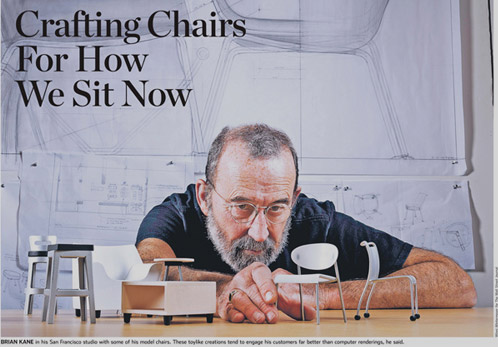

WHILE TEACHING a design class at California College of the Arts several years ago, Brian Kane noticed that his students often didn't sit. They instead draped themselves across their chairs or lounges, completely absorbed by their various electronic devices. Sealed off from the world by earphones and entranced by glowing screens, they were as likely to sprawl sideways as to sit up straight. Even in public places, many of them liked to rearrange the furniture and transform those spaces into their own customized zones for working, meeting or socializing.
Mr. Kane is an authority on public furniture design—the chairs, lounges, benches and sofas scattered around dorms, airports, hospitals and other public spaces. He's won over 80 design awards during his career, including several from the Industrial Designers Society of America. Two of the biggest office furniture makers, Herman Miller and Steelcase, have used his services.
One of Mr. Kane's biggest hits was a park bench dubbed Hyde Park, created in the early 1990s. Though made of steel, the bench has curved arms and back rests that make it look like an elegant sofa. Mr. Kane said he used a "living room approach" to defy park bench conventions. "I believe that if a chair or a bench looks comfortable, it will be sat on," he said. More than 7,000 of the benches have been sold so far.
As our habits evolve for sitting and sprawling in public, design needs have changed, too. That's been good for Mr. Kane, 64, who runs a three person design firm in San Francisco.
One of his recent projects is the Swoop line designed for Herman
KEEP ON DOODLING Brian Kane says that furniture design ideas come to him as he plays around with pencil sketches. He starts small then proceeds to a full scale drawing. Early development sketches for a new design, left.
Miller. Having noted the sprawling behavior of young device users, he created upholstered chairs with arms only on one side. They can be shoved together to form a love seat, or pulled apart for solo perching. The arm rests are curved to enhance the swooping design while discouraging students from setting their Coke cans on the upholstery. There are few seams, reducing the risks of crumbs collecting in crevices. Though the Swoop furniture is designed to let people flop however they like, Mr. Kane deliberately excluded long flat surfaces that would encourage napping.
Herman Miller introduced the Swoop line in late 2010 and said that more than 50 universities have bought it so
far. The list prices of Swoop chairs range from $1,050 to $1,800.
In addition to observing chair users in their habitats, Mr. Kane said that he gets ideas from doodling. "For me, it's just pushing a pencil till something good comes out."
He prefers Koh-I-Noor 2H lead pencils, with knurled metal grips, which cost about $10 each. Designers can use computers to draw, but Mr. Kane prefers to start with pencil and paper. "That is my favorite part of the process: having a good concept come alive on my drawing board!"
Before presenting a new idea to a manufacturer, Mr. Kane has one of his colleagues create a small model out of alder wood. These toylike creations tend to engage his customers far better than computer renderings, he said.
When he gets stuck during a design, Mr. Kane sometimes clears his head by going for a run. In his studio, a converted laundry truck garage in San Francisco's Outer Mission district, he plays edgy, newish rock music, such as the Black Keys and Band of Skulls.
"I like contemporary, exciting music, it energizes me," Mr. Kane said. Unlike many members of the baby boom generation, he doesn't like oldies. "I liked them when they were new," he said. He likes modern furniture and modern music. He prefers novelty to nostalgia.
As a teenager in Summit, N.J., Mr. Kane got his start by drawing portraits of famous people like Robert Kennedy and John Glenn. Then he mailed the portraits to their subjects, asking them to add their signatures and return the pictures to him. Most complied.
A high school counselor saw the portraits and encouraged Mr. Kane to pursue a creative career. His first choice was architecture, but the counselor didn't think Mr. Kane was strong enough in science and math and steered him instead toward industrial design. After getting a degree in that field at the University of Bridgeport in Connecticut, Mr. Kane went to work for a design studio in New York. He found himself working on such items as cheap clock radios, which gave him little scope for creativity.
He quit that job and moved to Italy, where, despite his inability to speak the language, he landed a job at a furniture studio. He had found his calling: "For me, furniture is sculpture. It just happens to be sculpture you sit on."
In addition to thinking about the public's unceasing appetite for digital devices, Mr. Kane now must design chairs that won't crumple under the weight of an increasingly heavy population. "As we have to design for bigger and bigger people, things are going to look like they're made of two-by-fours," Mr. Kane said. For legs and other structural elements, steel is often a better bet. The best he can do is to "try to hide a lot of that stuff."